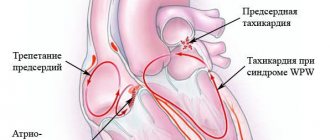Women of childbearing age (especially during pregnancy) often encounter varicose veins of the uterus. Diagnosis and, as a result, proper treatment of this disease has become possible in the last thirty years, when clinics began to be equipped with high-precision diagnostic equipment. If varicose veins are not treated in time, the woman may subsequently become infertile. To avoid this, you should contact a phlebologist at the first suspicion of the disease. Your obstetrician-gynecologist can also refer you to a phlebologist after an examination.
Diagnosis of uterine varicose veins
If uterine varicose veins are suspected, the doctor should refer the woman for examination. In modern medicine, various diagnostic methods are used for this:
- radiography;
- Ultrasound using a transvaginal sensor (echography);
- laparoscopy;
- Doppler ultrasound;
- CT scan.
Progressive diagnostic methods used in well-equipped clinics eliminate inaccurate diagnoses.
Varicose veins of the vulva and vagina
A characteristic venous pattern appears in the genital area. Gradually, varicose veins enlarge and swell. This makes the woman uncomfortable. If she does not consult a doctor for help, inflammation, thrombosis, and ulceration join the varicose veins. Varicose veins in the vagina are more difficult to notice due to their similarity to ordinary inflammation of the genitourinary system.
Symptoms:
- heaviness, discomfort, aching pain in the lower abdomen;
- burning sensation when urinating; itching at the entrance to the vagina after emptying the bladder;
- pain during defecation;
- discomfort and pain during sexual intercourse.
Women turn to a gynecologist complaining of discomfort, pain, and spotting during sex . During examination (vaginal examination), the doctor makes a diagnosis. He gives recommendations that must be followed.
A timely diagnosis prevents the possibility of complications. Using modern treatment methods for emergency indications, a pregnant woman is relieved of vaginal varicose veins long before giving birth.
Therefore it is important :
- register for pregnancy early ;
- do tests on time ;
- discuss changes in health, especially painful ones, with your doctor;
- do not engage in sexual intercourse , which is dangerous with varicose changes in the vagina and vulva.
During childbirth, varicose veins of the vaginal veins are complicated by injury to the changed vessels and venous bleeding . This becomes a serious complication in the postpartum period.
If the doctor has serious reasons to avoid such a risk, shortly before the expected date of birth, the woman is admitted to the hospital and undergoes a planned caesarean section .
Treatment of varicose veins of the uterus
Uterine varicose veins are treated in several ways. In the early stages of the disease, it is enough to undergo a course of medication, combining it with wearing compression garments and performing a set of physical exercises to improve blood circulation. Varicose veins during pregnancy sometimes go away after childbirth on their own without much effort.
In an advanced stage, when treatment does not bring results, surgery will be required. In particularly severe cases, the uterus must be amputated, but usually the disease can be cured simply by removing the problematic veins. The operation is carried out using various methods - it can be a conventional surgical or laser phlebectomy. The main thing is that healthy veins are not affected.
Causes of varicose veins in pregnant women
During pregnancy, a woman's hormonal background changes, the volume of blood in the body increases, the uterus increases in volume and compresses the lumen of the inferior vena cava. What happens to the body:
- blood flow is redistributed - an additional, embryonic circle of blood circulation appears;
- the venous load on the circulatory bed of the pelvis and lower extremities increases, complicating the outflow of blood from the legs to the heart;
- body weight increases;
- the volume of circulating blood doubles;
- the load on the heart muscle increases;
- blood clotting increases;
- venous blood flow slows down;
- venous vascular walls weaken under the influence of progesterone;
- intravascular venous pressure increases (especially in the legs).
How does varicose veins develop?
Increased levels of progesterone , characteristic of the hormonal background of pregnancy, weaken the muscle tone of the venous wall throughout the vascular bed of the body. The increased volume of blood in blood vessels with weakened walls overwhelms and deforms them. Many pregnant women develop varicose veins.
Varicose veins are also possible due to the growth of the fetus and uterus . When expanded, they put pressure on the large vessels of the pelvic cavity (especially the inferior vena cava and right ovarian vein), which disrupts the outflow of venous blood to the heart. Venous stagnation of the underlying sections fills the vascular bed with blood, dilating the veins of the pelvis, genitals, groin, and lower extremities. As a result, varicose veins of the superficial system occur. In this case, the deep vein system of the lower extremities does not suffer, since they are located in a muscular sheath.
Signs of varicose veins
Most often, it all starts with visual manifestations. Spider veins and reticular veins appear. Then there are clinical symptoms: swelling of the lower extremities at the end of the working day, heaviness, fatigue, a feeling as if the legs are on fire. Some patients experience a condition called restless legs syndrome. In more advanced stages, skin changes (redness, thickening, soreness) may be observed along the course of varicose veins. This condition is characterized as thrombophlebitis. Trophic changes in the skin and the formation of trophic ulcers on the affected lower limb may also occur.
Types and stages
Main types of disease:
- Focal adenomyosis. Tissue proliferation occurs in the form of individual foci.
- Nodular adenomyosis. The main symptom is adenomyomas (nodes), shaped like fibroids. They are represented by cavities with a dense shell and blood filling.
- Diffuse adenomyosis. One of the complex forms in which individual foci are not observed in the endometrium.
- Diffuse nodular form of adenomyosis. Signs of nodular and diffuse forms are observed.
What degrees of adenomyosis exist:
- First. Only the submucosal layer of the endometrium is affected.
- Second. The cells spread to the muscle layer, but affect no more than half of its depth.
- Third. The submucosal layer and more than 50% of the depth of the muscular layer are affected.
- Fourth. The process already affects the entire muscle layer, and can also affect neighboring tissues.
Varicose veins of the pelvis
1. BASIC CONCEPTS Website is a personal website (indicate the affiliation of the site), located on the Internet at the address: www.begma.ru. Site Administration – IP Smirnova Lyudmila Petrovna644 048 Omsk, st. Angarskaya 2 sq. 8. User – an individual or legal entity who has posted his personal information through the Feedback Form on the site with the subsequent purpose of transferring data to the Site Administration. Feedback form is a special form where the User places his personal information for the purpose of transferring data to the Site Administration. 2. GENERAL PROVISIONS 2.1. This Privacy Policy is an official standard document of the Site Administration and determines the procedure for processing and protecting information about individuals and legal entities using the Feedback Form on the Site. 2.2. The purpose of this Privacy Policy is to ensure adequate protection of information about the User, incl. his personal data from unauthorized access and disclosure. 2.3. Relations related to the collection, storage, distribution and protection of information about users are governed by this Privacy Policy and the current legislation of the Russian Federation. 2.4. The current version of the Privacy Policy is a public document, developed by the Site Administration and is available to any Internet User by clicking on the “Privacy Policy” hypertext link. 2.5. The Site Administration has the right to make changes to this Privacy Policy. 2.6. When changes are made to the Privacy Policy, the Site Administration notifies the User by posting a new version of the Privacy Policy on the Site www.begma.ru. 2.7. When a new version of the Privacy Policy is posted on the Site, the previous version is stored in the documentation archive of the Site Administration. 2.8. By using the Feedback Form, the User agrees to the terms of this Privacy Policy. 2.9. The Site Administration does not verify the accuracy of the information received (collected) about the User. 3. CONDITIONS AND PURPOSE OF COLLECTION AND PROCESSING OF USERS' PERSONAL DATA 3.1. Personal data of the User such as: first name, last name, patronymic, e-mail, telephone, skype, etc., are transferred by the User to the Site Administration with the consent of the User. 3.2. The transfer of personal data by the User to the Site Administration through the Feedback Form means the User’s consent to the transfer of his personal data. 3.3. The Site Administration processes information about the User, incl. his personal data, such as: first name, last name, patronymic, e-mail, telephone, skype, etc., as well as additional information about the User provided by him at his own request: organization, city, position, etc. in order to fulfill obligations to User of the Site. 3.4. The processing of personal data is carried out on the basis of the principles: a) the legality of the purposes and methods of processing personal data and good faith; b) compliance of the purposes of processing personal data with the goals predetermined and stated when collecting personal data; c) compliance of the volume and nature of the processed personal data with the methods of processing personal data and the purposes of processing personal data; d) the inadmissibility of combining databases containing personal data created for incompatible purposes. 3.5. The Site Administration processes the User’s personal data with his consent for the purpose of providing services/selling goods offered on the Site. 4. STORAGE AND USE OF PERSONAL DATA The User’s personal data is stored exclusively on electronic media and is used strictly for the purpose specified in clause 3 of this Privacy Policy. 5. TRANSFER OF PERSONAL DATA 5.1. The User's personal data is not transferred to any third parties, except for the cases expressly provided for in this Privacy Policy and specified in the Consent to the newsletter.
5.2. The provision of the User’s personal data at the request of state bodies and local governments is carried out in the manner prescribed by the legislation of the Russian Federation. 6. STORAGE TERMS AND DESTRUCTION OF PERSONAL DATA 6.1. The User’s personal data is stored on the website’s electronic media indefinitely. 6.2. The User’s personal data is destroyed at the request of the User himself based on his request, or at the initiative of the Site Administrator without explanation, by deleting the information posted by the User by the Site Administration. 7. RIGHTS AND OBLIGATIONS OF USERS Users have the right, upon request, to receive from the Site Administration information regarding the processing of their personal data. 8. MEASURES TO PROTECT USER INFORMATION The Site Administrator takes technical, organizational and legal measures to ensure the protection of the User’s personal data from unauthorized or accidental access to it, destruction, modification, blocking, copying, distribution, as well as from other unlawful actions. 9. USER REQUESTS 9.1. The User has the right to send his requests to the Site Administration, incl. regarding the use/deletion of his personal data, provided for in clause 3 of this Privacy Policy in writing to the address specified in clause 1. 9.2. The request sent by the User must contain the following information: for an individual: – number of the main document identifying the User or his representative; – information about the date of issue of the specified document and the issuing authority; – date of registration via the Feedback Form; – text of the request in free form; – signature of the User or his representative. for a legal entity: – request in free form on company letterhead; – date of registration via the Feedback Form; – the request must be signed by an authorized person accompanied by documents confirming the person’s authority. 9.3. The Site Administration undertakes to consider and send a response to the User's request within 30 days from the date of receipt of the request. 9.4. All correspondence received by the Administration from the User (applications in written/electronic form) refers to restricted information and is not subject to disclosure without the written consent of the User. Personal data and other information about the User who sent the request cannot be used without the special consent of the User other than to respond to the topic of the received request or in cases expressly provided for by law.
Causes of development of varicose veins of the pelvis
Today, the main cause of varicose veins is considered to be a history of pregnancy. The situation arises due to the fact that the growing fetus puts pressure on nearby organs and vessels, disrupting blood circulation. A healthy female body after childbirth is able to restore blood circulation on its own and no problems arise. However, under the influence of certain provoking factors, the tone in the vessels is not restored, leading to vascular pathology.
Factors contributing to the occurrence of the disease:
- excessive physical activity;
- sedentary lifestyle;
- diseases of the reproductive system (tumors, polycystic disease, endometriosis, etc.).
It is worth noting that varicose veins of the venous vessels of the pelvis can occur not only during pregnancy. Recently, scientists have been actively discussing the effect of hormonal contraceptives and hormone-containing drugs on the development of venous pathology. This assumption is based on the fact that the disease occurs much more often in women of childbearing age, which means hormones play a major role in this process.








